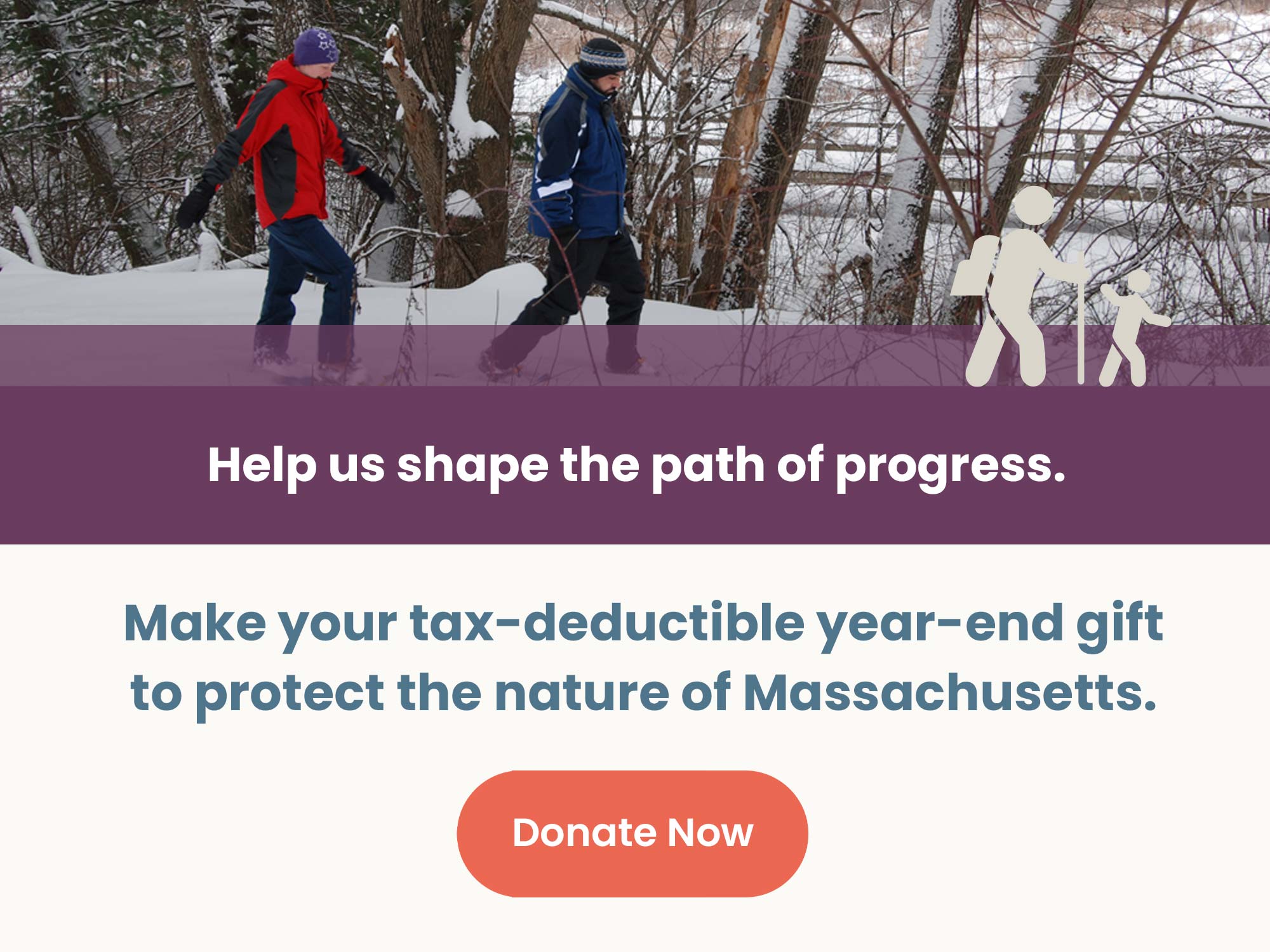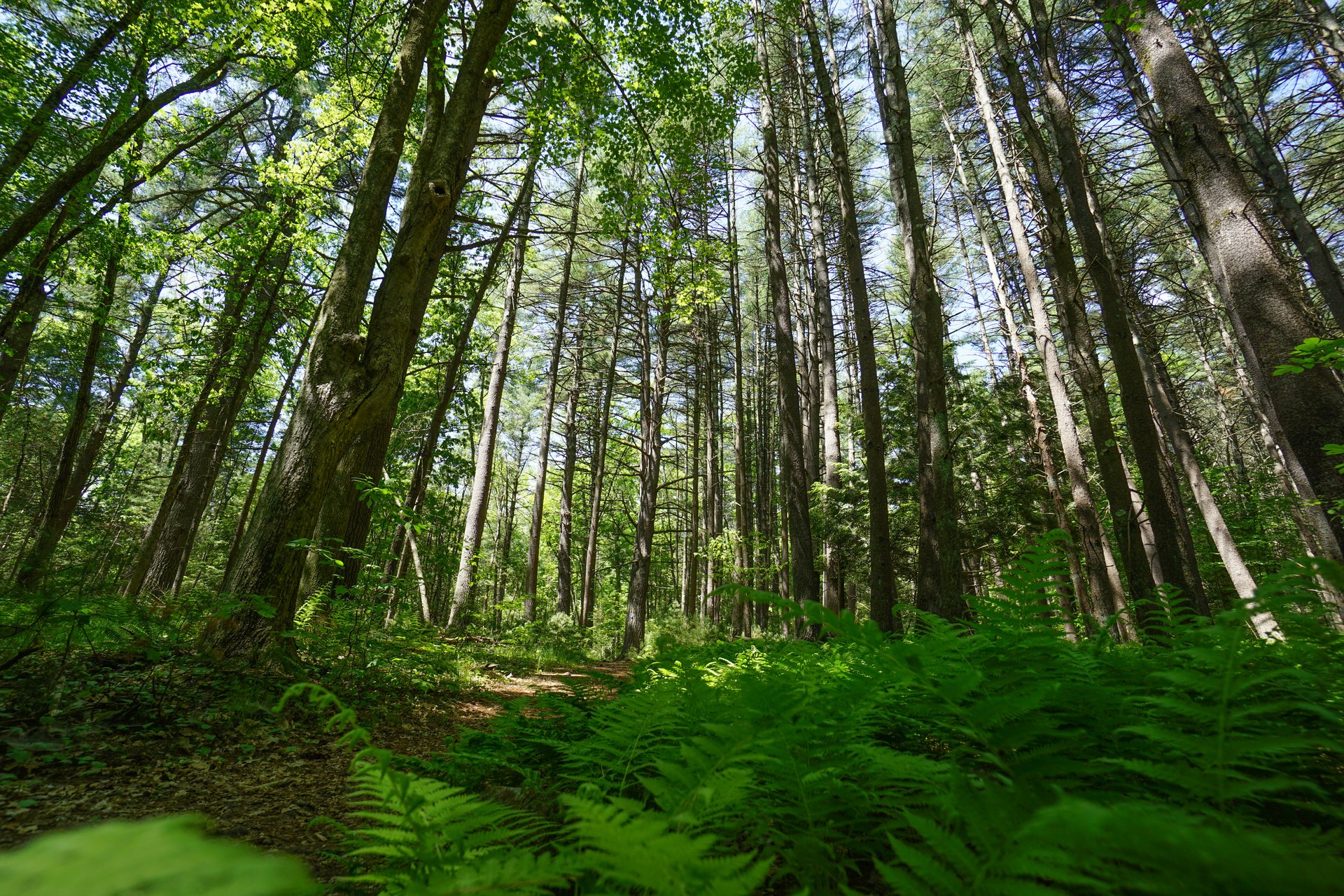Resilient Lands
Capturing Carbon
Mass Audubon is committed to fighting climate change through conservation, advocacy, and education. And we are always looking for innovative ways to make a real and lasting impact. Our recent entry into the California Air Resources Board (CARB) carbon offset market is a prime example.
Establishing a price on carbon is an effective way to harness economic pressure to force carbon emissions reductions, but no policy has yet been implemented at the federal level. The best model is California’s comprehensive carbon emissions reduction campaign, which includes a cap-and-trade program for industries.
Mass Audubon has enrolled 10,000 acres of our forests in a CARB Improved Forest Management project, the first of its kind in Massachusetts. Since the carbon stored in these acres exceeded the regional average value, we were awarded more than 600,000 offset credits, which were then sold on the CARB carbon offset market.
A Closer Look at Cap & Trade
Greenhouse gases like carbon dioxide trap heat in the atmosphere, resulting in worldwide, anthropogenic warming that’s driving changes in our environment. Reducing the amount of carbon dioxide in the atmosphere is one of the most important actions we can take to fight climate change, and one of the best ways to do that is to store that carbon in trees. Forests cover more than 60% of Massachusetts and remove approximately 14% of the state’s yearly greenhouse gas emissions from the atmosphere.
As part of its carbon emissions reduction program, California has created a cap-and-trade program, which establishes an upper limit—the "cap"—on the total carbon volume that can be emitted annually by various industrial sectors in the state. Regulated entities are required to obtain a credit, representing one ton of carbon dioxide, for every ton of carbon dioxide that they emit. These credits—known as allowances when issued by the state, or offsets if generated by a third party—can be bought and sold through the carbon market—the "trade."
The cap, determined by the number of allowances issued by the state, declines every year to drive a continual reduction in overall emissions. While Massachusetts participates in a regional greenhouse gas cap-and-trade program, it is not as comprehensive as the California market. The expansion of this program is a Mass Audubon legislative priority.
Looking Forward
By enrolling the 10,000 acres and selling the offset credits, Mass Audubon has committed to maintaining the carbon stored in these forests for at least 100 years. In return, the funds generated from the sale will support our work—including land stewardship and climate education programs—so we can continue to fight against climate change in all that we do.
Frequently Asked Questions
Find answers to the most frequently asked questions about this project.
We chose to participate in the California Air Resources Board (CARB) offset market because it is part of one of the first compulsory, economy-wide programs to put a price on carbon emissions. By placing limits on total GHG emissions from large industrial sources, CARB’s program requires major polluters to pay for their GHG emissions. Moreover, California’s climate regulations require that the vast majority of reductions in greenhouse gas (GHG) emissions be made by polluters themselves—the use of credits, or "offsets," generated by forestry and other carbon projects, is limited to a small fraction of the program’s overall GHG reduction requirements.
Yes. We manage our forested acres for multiple values including wildlife habitat, but over the next century, we have committed to manage the nearly 10,000 acres of conserved lands enrolled in CARB’s offsets program to optimize for carbon. Funds from the program enable us to improve forest management (e.g., invasive plant management) to maintain and increase forest stocking to greater levels than we could otherwise. In addition, we will deploy funds from California’s offset program to purchase, protect, and manage additional lands for their ability to perform additional carbon removal. We have already purchased and added 118 acres of forest to our Whetstone Woods Wildlife Sanctuary, and we expect to add another 150 acres this year, and a few hundred more in the next few years. In addition, we have endowed 100 years of intensive forest monitoring to ensure the forests enrolled in the program continue to store and sequester carbon. Importantly, we will fund even more strategic land purchases for carbon and climate resilience, and support Mass Audubon’s climate change program.
Offsets are designed to be purchased by greenhouse gas emitters regulated in California. Our offsets were initially purchased by Statkraft, a Norwegian renewable energy company. Statkraft subsequently sold the offset credits to companies regulated under California’s cap-and-trade program, including Phillips 66, SoCalGas, and Shell North America.
No. California’s cap-and-trade system is a mandatory market and one of the first in the world to put a price on carbon emissions. As of 2012, all large facilities that emit greenhouse gasses in California are required to either reduce their emissions directly, or pay for each ton of carbon they emit. Most other states and countries allow GHG emissions to be released for free—exceptions to this include the Regional Greenhouse Gas Initiative, which regulates GHG from large power plants, and Europe’s Emissions Trading System. In April 2021, Washington State passed legislation establishing a cap-and-invest program that limits GHG emissions from large sources (power plants, industrial sources). This program may link to California’s program.
These jurisdictions are the first globally to place legal limits, or caps, on GHG emissions. Because very few governments have regulated carbon before, these programs are untested, and the costs of compliance are uncertain. The role of offsets in California’s program (and others like it) is to provide a lower-cost option for polluters to comply with the requirements, and avoid raising energy costs to consumers and ratepayers. However, as mentioned above, offsets can only be used for a small fraction—no more than 8%—of overall program compliance in California. Polluters must make the vast majority of GHG emissions reductions.
California’s offset program itself is also very rigorous. Project protocols, developed by technical experts in transparent public processes, reflect best practice for high-quality offsets. The program has been challenged multiple times and upheld by California courts each time.
In this way, we are confident that our participation in the carbon offset program does not enable “extra” emissions; rather it supports a system driving down GHG emissions over time in a cost-effective way, while also providing modest funding for carbon removal by forests and other ecosystems.
Strategies to enhance carbon storage and resilience provided by natural lands to combat climate change are broadly labeled Nature Based Solutions (NBS). NBS are essential to addressing climate change. We will not limit global temperature increases to 1.5-2°C by 2050 unless we stop loss of forests and natural lands and significantly increase the pace of natural carbon storage. Recent estimates find that globally, NBS may provide up to one-third of total carbon removal needed to reach long-term climate goals.
Not only do NBS remove massive quantities of CO2 emissions from the atmosphere, they also help us adapt to climate change’s most pressing impacts. They provide a critical buffer against severe weather, sea level rise, extreme heat on people and communities, and more.
We have the option to sell additional offset credits periodically based on incremental growth of the enrolled forest, providing modest income that could further support sanctuary stewardship and operations. Additional sales require additional administration and extend the 100-year commitment. We have not yet decided whether we will sell additional offset credits.
It is absolutely critical that we develop policy mechanisms to spur greater investments in Nature Based Solutions (NBS). Cap-and-trade programs with offsets is one way to do this, but we acknowledge that there are challenges with implementing offset markets. Offset programs will provide some funding for NBS. But we believe additional policy mechanisms and even more funding to deploy Nature Based Solutions to levels needed to meet the climate challenge.
Yes. In the fight against climate change, it is critical that a price be placed on GHG emissions. California’s cap-and-trade system was the first economy-wide program to do so in the country; we are proud of the precedent we set by participating in this pathbreaking program. Additionally, project revenues will support new land conservation and a century’s worth of forest stewardship and monitoring at Mass Audubon. We expect that carbon pricing policies and programs will evolve and improve over time, ensuring that polluters pay for GHG emissions while increasing funding to compensate for Nature-based Climate Solutions for their essential carbon removal services.
Last updated May 2021



